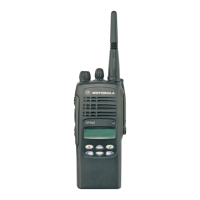8
English
BASIC USER GUIDE
GETTING STARTED
Radio On-Off/Volume Control
To turn the radio on, turn the On-Off/Volume Control
knob clockwise. To turn the radio off, turn the
On-Off/Volume Control knob counterclockwise until
you hear a click.
At power up the radio will display a message
customised by your dealer,:
After this text has been displayed, the radio perform
a self test routine. On completion of a successful
self test the radio will display:
This may be a number or an alias and will be the
channel currently selected by the rotary channel
selector. Alternatively, if required the radio may
display a message customised by your dealer. e.g.
Selecting a Radio Channel
Turn the channel selector rotary knob clockwise or
counterclockwise until you reach the desired
channel indicated on the display.
Sending a Call
1. Select the desired channel.
2. Press the PTT button and speak clearly into the
microphone.
Your mouth should be 2.5 to 5 cm away from
the microphone.
3. Release the PTT button when you finish
speaking.
Note:The system may have a limited call time and
the call may be terminated automatically if this
call time is exceeded.
Receiving a Call
1. Turn your radio on and adjust the volume level.
2. Switch to the desired channel.
3. If, at any time, a call is received you will hear
the call at the volume level you have set.
Cancelling/Ending a Call
To terminate a call at any time press the Monitor/
Call Cancel button. Always end a call by pressing
the Monitor/Call Cancel button.
Radio On
Channel Number
Ready

